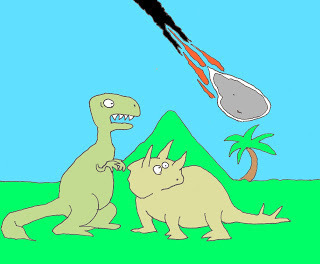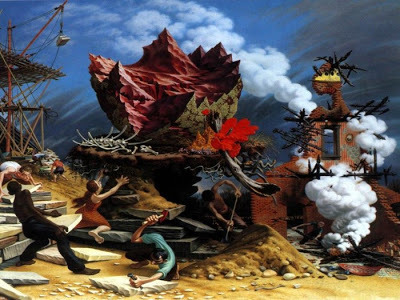Man Martin's Blog, page 155
August 6, 2013
Holly Bushes vs Zombies
 The time has come to kill the holly bush in our front yard. It is growing right at the base of an oak, in the very crotch of two roots. Nancy has doused it in Roundup, cut back the branches, and chopped at the roots. Nothing. She cursed at it. The holly merely laughed. The time had come to turn to an expert. When an expert couldn't be found, I volunteered.
The time has come to kill the holly bush in our front yard. It is growing right at the base of an oak, in the very crotch of two roots. Nancy has doused it in Roundup, cut back the branches, and chopped at the roots. Nothing. She cursed at it. The holly merely laughed. The time had come to turn to an expert. When an expert couldn't be found, I volunteered.Naturally, the first thing a he-man type like me does when confronted with a holly bush, is look it up on the Internet. This is my standard operating procedure for everything. If I woke up, smoke billowing overhead and flames licking at the comforter, I wouldn't waste a minute before typing "house fire" in google.
Holly is a plant with glossy green leaves with little spiky things on them, making them a great deterrent to trespassers, as well as gardeners and homeowners. They are evergreens, meaning they shed sturdy, impossible-to-decompose-leaves all year long, forming a luxuriant bed around the base of the trunk of brown crunchy leaves with spiky things, making holly as unpleasant to walk around as it is to touch. With a male holly plant, you only get to enjoy the leaves, but female hollies create beautiful candy-red berries, which cause vomiting and diarrhea in children and adults, and can be fatal to pets.
You can see why they are so popular as ornamental bushes.
Best of all, once planted, hollies are all but impossible to get rid of!
Browsing the Internet, I found the number one most popular way to get rid of a holly plant is to dig out around the roots, tie a chain to them, and pull it out with a pickup truck. This seemed to work most of the time, although one woman said it bent her truck bumper.
I can't use the truck procedure because
A. I don't own a truck, and
B. Even if I did, I'm not sure I could get a chain around the roots given the odd position of this bush.
Therefore, I'm going with the second most popular method, which is cutting back all the branches, digging out around the roots to expose the stump, drilling holes, and filling them with stump rot.
Zombies are notoriously hard to deal with, and indeed have become an all-purpose metaphor for any problem that won't seem to go away no matter what you try. But in every zombie movie I've seen, an infallible technique is to shoot the zombie in the brain. If you don't have a gun, you can use an axe, sledgehammer, or even a golf-club. Compare the relatively straight-forward procedure against what I must to do a holly bush, which may or may not even work.
Holly hell.
Published on August 06, 2013 03:44
August 5, 2013
Fellow Authors: I Need You
 Here's the deal; on this blog I'm planning to post a recurring feature by guest authors, "Things I Know Now I Wish I'd Known Then." It would feature authors sharing whatever wisdom they've gained since the publication of their first book. It need not be about publishing or the craft of writing per se, although that's welcome; it could be what you've learned about yourself, spirituality. the political scene, or Texas Hold'Em, whatever discoveries you've made and in any format you wish to present them. You can write traditional essay, fictional narrative, poetry, pie charts. It's all up to you, and the more creative and individual, the better.
Here's the deal; on this blog I'm planning to post a recurring feature by guest authors, "Things I Know Now I Wish I'd Known Then." It would feature authors sharing whatever wisdom they've gained since the publication of their first book. It need not be about publishing or the craft of writing per se, although that's welcome; it could be what you've learned about yourself, spirituality. the political scene, or Texas Hold'Em, whatever discoveries you've made and in any format you wish to present them. You can write traditional essay, fictional narrative, poetry, pie charts. It's all up to you, and the more creative and individual, the better.The blog would feature a brief bio plus a picture of your smiling mug and the cover of your book, plus links to the online vender or the bookstore of your choice and your website.
If you'd like to play, let me know via this blog, email, or Facebook.
I look forward to hearing from you, and keep writing!
- Man
Published on August 05, 2013 02:48
August 4, 2013
Cross is "Real Deal" Claim Archeologists
 (Huffington Post) Archaeologists working in Turkey believe they have found a piece of the cross that Jesus was crucified on.
(Huffington Post) Archaeologists working in Turkey believe they have found a piece of the cross that Jesus was crucified on.Moe DaGrasse, renowned archaeologist and tanning-bed entrepreneur: Yep, this cross here, it's the real deal. No doubt about it. The very cross Jesus was nailed on, the Jeezter Himself, the Christ-oman, the Messiahster.
So how can we be so sure this is the real deal and not some phony? First of all, you got to examine the box it came in. The box says, in clear letters, "This here box contains the true original cross of Jesus H. Christ." You can't get much better proof than that, can you? I mean, if you got a box that says, "Big Mac," it's not gonna have a Wendy's Burger in it, is it? By the way, have you tried that new Wendy's burger with the bacon and the pretzel roll? Dee-lish.
Also, you got to examine the cross itself. We did that. I mean, what kind of world-renowned archaeologist wouldn't examine the cross. It says on it, right on the underside, "Palestine Hardware." Now, here's where expert knowledge comes into play, because I happen to know, those Roman soldiers went exclusively to Palestine Hardware for all their crucifixion lumber needs. We had the wood analyzed, and it's sturdy heart-of-pine. That's just the sort of wood you'd use if you had some major crucifying to do. I mean, you're not going to nail the Son of God onto balsa wood, it'd fall right over. You'd use heart of pine: sturdy, durable, easy-to-paint.
Also, and this is an exclusive cause we haven't told nobody else this, the cross wasn't the only thing in the box. There were other things. Like the bill for the last supper, and a the list of animals Noah took on the ark. You can see where he crossed out "unicorns" right between "umbrella birds" and "vampire bats." Also, we found a shaker of salt we think might have come directly from Lot's wife. We're not sure about that one yet. Could just be ordinary salt, you never can tell.
Published on August 04, 2013 04:28
August 3, 2013
The Queen's Speech
 LONDON (Reuters) - Relations between the Soviet Union and the West had become so tense 30 years ago that British officials drew up a speech for Queen Elizabeth to deliver to the nation in the event of a nuclear war, newly released archives showed on Thursday.
LONDON (Reuters) - Relations between the Soviet Union and the West had become so tense 30 years ago that British officials drew up a speech for Queen Elizabeth to deliver to the nation in the event of a nuclear war, newly released archives showed on Thursday.First of all, I'd just like to say, BOOM! Ha-ha, just kidding! I always feel a little levity brightens every situation, don't you?
This is a dark hour for Britain and the rest of the world, and I'm sure many of you are frightened for what the future holds. At a time like this, it's important to think of others. For example, just try to imagine how I feel. I mean, what have you got to lose? A one-room walk-up flat, most of you, with a loo down the hall and the smell of cumin always in the air because of whatever your Pakistani neighbor's been cooking. Me, though, I live in a palace. Palaces, actually, and I rotate between them. I basically own the whole country when you get right down to it. I mean, if this really turns out to be Armageddon, I'm pretty well screwed.
Thank goodness the rest of the royal family and I have our secret bomb-proof underground chamber to go to, which is already stocked with truffles, champagne, and pate de fois gras, otherwise, the thought would just be too, too terrible to endure. I wish I could invite all of you to come down with us, but it's top-tippy-top secret and I'm only telling you now because you'll all be vaporized in a matter of hours anyway. Besides there's only just enough room for the royal family, our personal staff, and Prince Harry's hand-picked retinue of supermodels. (Boys!)
Meanwhile, I just want you to know, that the family and I will be thinking of you, there on the surface, amid the smoking wrecks of once-great cities, populated by giant mutant cockroaches our scientists predict will swarm the earth. We won't think of you right away, frankly, because we're having a costume party this weekend - I do hope Harry doesn't wear that atrocious Nazi Africa Korps uniform again - but as soon as that's over, I'll be thinking of you twenty-four, seven, but actually, come to think of it, you should all be dead midweek, so I'll think of you twenty-four, four. Right after the costume party.
Toodle-oo.
Published on August 03, 2013 03:50
August 2, 2013
Waiting for the Death Meteor
 Now on top of everything else, NASA’s pestering me to tackle Death Meteors. Nobody takes Death Meteors more seriously than I do, but I’m already up to my elbows with other crises. Hummingbird-feeders, for example. My wife’s lobbying to remove all eight feeders from the eaves, on grounds they’re an eyesore, a position not without merit. Visualize red plastic containers sprouting bright yellow plastic flowers, so obviously fake, they wouldn’t fool anybody who isn’t dumb as a hummingbird. The problem is, hummingbirds think tacky yellow flowers are beautiful, and nothing will budge their conviction that these represent the pinnacle of artistic achievement. Can I help that nature’s loveliest, jewel-like denizens have moronic taste?But with my wife out of town, I can turn my attention to Death Meteors.In case you slept through science class, a Death Meteor one point five jillion years ago explains why you never see dinosaurs nowadays unless you count alligators, telephone solicitors, and Komodo Dragons. This particular Death Meteor was named Chicxulub, which was asking for it. Naming a meteor something badass like Chicxulub is simply looking for trouble, which is why scientists started naming meteors nonthreatening things like DA14. DA14, you might recall, was the football-field-sized space-lump that came this close to walloping us last year.
Now on top of everything else, NASA’s pestering me to tackle Death Meteors. Nobody takes Death Meteors more seriously than I do, but I’m already up to my elbows with other crises. Hummingbird-feeders, for example. My wife’s lobbying to remove all eight feeders from the eaves, on grounds they’re an eyesore, a position not without merit. Visualize red plastic containers sprouting bright yellow plastic flowers, so obviously fake, they wouldn’t fool anybody who isn’t dumb as a hummingbird. The problem is, hummingbirds think tacky yellow flowers are beautiful, and nothing will budge their conviction that these represent the pinnacle of artistic achievement. Can I help that nature’s loveliest, jewel-like denizens have moronic taste?But with my wife out of town, I can turn my attention to Death Meteors.In case you slept through science class, a Death Meteor one point five jillion years ago explains why you never see dinosaurs nowadays unless you count alligators, telephone solicitors, and Komodo Dragons. This particular Death Meteor was named Chicxulub, which was asking for it. Naming a meteor something badass like Chicxulub is simply looking for trouble, which is why scientists started naming meteors nonthreatening things like DA14. DA14, you might recall, was the football-field-sized space-lump that came this close to walloping us last year.Football Fields (FF) are the standard unit of measure for Death Meteors just as hail is measured in Golf Balls (GB).
Published on August 02, 2013 03:17
August 1, 2013
You Can't Beat Home-Grown Vegetables
 Al Capp's classic comic strip, Li'l Abner, had something called "the Dogpatch Ham." Huge, nourishing, and seemingly alive, the Dogpatch Ham had nourished Yokum family for generations and would do so for generations to come. No matter how much you sliced from it, there was still more left over, and in fact, the total quantity of ham never seemed to diminish.
Al Capp's classic comic strip, Li'l Abner, had something called "the Dogpatch Ham." Huge, nourishing, and seemingly alive, the Dogpatch Ham had nourished Yokum family for generations and would do so for generations to come. No matter how much you sliced from it, there was still more left over, and in fact, the total quantity of ham never seemed to diminish.I believe I am in possession of the exact same thing, only with a zucchini squash. Earlier this summer, Nancy and I found an overlooked zucchini nestled among the leaves. I will not say it was so deep as a well nor so wide as a church door, but 'twould do, 'twould do. We didn't eat the whole thing all at once, of course, it would have required a battalion of squash-eating soldiers; nevertheless, we sliced up some that very night and cooked it - you can't beat home-grown vegetables - and the rest we put in the refrigerator.
The squash remained in the refrigerator, still perfectly edible, and we've had it from time to time - sauteed, baked, even grilled. As I say, you can't beat home-grown vegetables. The thing is, no matter how much we eat, the squash never seems to get any smaller. I believe we may have grown an infinite squash that will feed us for the rest of our lives. What a wonderful, wonderful blessing.
In fact, I'm not altogether sure that squash isn't getting larger. After my tasty squash omelet this morning, served up with squash fritters and grits, I could have sworn the thing had grown a couple of centimeters. Is it possible that a squash, separated from its vine and placed in a refrigerator crisper drawer could continue to live and grow? Could it have become an independent organism? Could it have developed intelligence? Could it hear what I say? Could it be sneaking out at night to read this blog?
Ha ha! Just kidding! I think!
The thing is, I swear it's getting bigger, and it won't spoil, and we picked it in June. Keep in mind zucchini squash have been specifically bred as foodstuffs - that's their whole reason for being - it's what they want to do. Like the big-headed aliens on The Twilight Zone, their motto is, "To serve mankind." What if this one has somehow developed an autonomous will and is determined to feed us, forever, and ever, and ever?
What if it's true, that you just can't beat home-grown vegetables, no matter how hard you try, you just can't beat them? Dear Lord, what if it's true?
Published on August 01, 2013 04:06
July 31, 2013
My Toenails
 Many years ago, I had cute toenails. I am not bragging, merely stating an objective fact. My toenails were definitely cute. Some would have even called them adorable. Starting at about age 30, however, my toenails began to transform, gradually turning into the things of horror they are today.
Many years ago, I had cute toenails. I am not bragging, merely stating an objective fact. My toenails were definitely cute. Some would have even called them adorable. Starting at about age 30, however, my toenails began to transform, gradually turning into the things of horror they are today.Nancy will demur; my toenails were never all that cute, she will say. Many is the night I would cuddle up beside her in bed, and she would say, "For God's sake, when are you going to trim those things?" But even she will admit compared to the way they are now, my former toenails were cuteness itself.
I do not know what has caused my toenails to age exponentially faster than the rest of my body. My fingernails, for example, seem as spry and vigorous as ever. Medically speaking, I have the fingernails of a seventeen-year old, but owing to some freakish Dorian-Grey-type phenomenon, my toenails are transmogrifying at a fantastic rate, as if they had to bear the physical evidence of all the sins and misdeeds of my life, along with all Nancy's sins and misdeeds, plus the dog's and the chicken's, and possibly at least one of the neighbor's.
Indeed, my toenails no longer seem like human toenails at all. They look as if they'd been transplanted from some wild and savage beast. A beast with remarkably ugly toenails.
Ironically, even as my toenails become ever more deformed and discolored, they are becoming stronger. There is something Frankensteinish in this. Nothing so repulsive should be so durable. They no longer seem to be made of ordinary toenail material at all, but some unnaturally tough animal hoof. I have seen the bent and twisted metal my toenails have made of ordinary nail clippers. I have considered resorting to hedge trimmers, were they not so unwieldy to handle I might lose an entire toe.
Briefly I contemplated visiting a pedicurist, but I was only fooling myself. Nothing could fortify me against the shame of revealing these horrid tootsies to a stranger. The face of some nice Korean lady would blanch and her jaw would drop in mute alarm. Other customers would flee. I would be sent from the shop at once, but nothing would prevent the recurrent nightmares that would haunt the witnesses for years to come. Besides, nothing in her arsenals of clippers or emery boards would avail against these claws. You might as well try to moisturize a rhinoceros hide.
So nothing remains to do with my toenails but hide them from the world. Cover them in thick socks and then put them in shoes where no one will have to behold them. When the socks, and even the shoes, become shredded at the toes as if the nails were some rabid rat feverishly chewing its way through burlap, I will just have to replace them. I only hope the day never comes shoes and socks no longer conceal my toenails because they have become too disproportionate and misshapen. But my mortician! My poor mortician! He - or she, God forgive me if it's a she - will have to behold my gruesome toenails unadorned. What monstrosities will they be by that time?
But it can't be helped. I will leave instructions that my body be handled by a blind mortician if at all feasible. If not, I will recommend tying a kerchief over the eyes or averting the gaze from my feet at the very least. As for the toenails, I recommend they be buried in a separate casket. A stake through their heart.
Published on July 31, 2013 03:43
July 30, 2013
Chicago's Rivers
 I saw this painting, "The Rock," by Peter Blume at the Art Institute in Chicago,
I saw this painting, "The Rock," by Peter Blume at the Art Institute in Chicago, and while it has nothing specifically to do with today's blog,
it catches the spirit of the thing I'm writing about.
Just look at the out-sized fist of the hammer-swinger in the foreground.I've been home from Chicago for two days now, but my head is still full, so here are some additional musings.
What makes Chicago the city it is, is that it - like New Orleans and DC - was built on a swamp. What a grand and hubristic thing to build on a swamp. Remember the Monty Python King who built his castle on a swamp? "Everyone said it was daft to build a castle on a swamp, but I did it anyway. It sank into the swamp. So I built another. It sank into the swamp. So I built another. It burned down, fell over, then sank into the swamp. But the fourth castle stayed up!" Good for you, Monty Python king! And good for you, Chicago.
I don't know how the king did it, but Chicago started by laying down a firm substratum of garbage as a foundation. Their rivers, of which more on later, were not only their source of commerce and drinking water, but a handy sewage system for any garbage they weren't using for landfill. The Cuyahoga in particular became so polluted, it caught fire thirteen times! To be fair, not all of these were Chicago's fault; nevertheless, there is something almost sublime in the human ability to spawn such an unnatural natural disaster as a river catching fire. As the Randy Newman song has it, "The lord can make you tumble, the lord can make you turn. The lord can make you overflow, but the lord can't make you burn. Burn on, big river, burn on."
Apart from catching a river on fire, Chicago also succeeded in making a river change direction. Not change course, that's been done lots of times, but direction. The Chicago River which originally flowed into Lake Michigan, now flows out into the Mississippi River Basin. There is a Paul Bunyan story accounting for this, and while Paul Bunyan is not a true tall-tale figure - in what sense is a tall-tale ever true? - the story is so clever, I'll summarize it here.
Paul Bunyan was asked by the city fathers to do something about Chicago's river. It was ideal for transporting lumber and whatnot from Lake Michigan down to the Mississippi, except it inconveniently pointed the wrong way. Now whenever Paul had serious thinking to do, he liked to eat popcorn, so the cook popped him up a couple of freight-train loads, and Paul sat munching and cogitating. As he ate, the falling popcorn crumbs convinced the birds it was snowing, and they all flew south for the winter. This gave Paul his idea. He fetched an ice storm down from the North Pole and dumped it onto the river, freezing it solid from the top down to the riverbed. Then, working quickly before it thawed, the lumberjacks cut the river into sections, rotating each one 180 degrees before setting it back in place. They finished just in time, and when the river thawed out, it was flowing in the opposite direction.
The ancient Greeks would have predicted dire consequences for such human arrogance. You might solve the Sphinx's riddle one day and save the city, but the gods were watching, their fingers itching on their lightning bolts, just waiting to put you back in your place, ie under their heel. Hubris was always followed by Nemesis. But Chicagoans aren't ancient Greeks, and I say hurray for them. Jurasic Park teaches the same warning against pride, but what American walks away from that movie who doesn't think, "Dinosaurs, cool! Wouldn't it be neat, if we could really make dinosaurs!" That's how it is with Chicagoans; they'll fight today's fight today and worry about tomorrow's tomorrow. The Greeks say, "Call no man happy 'til he dies," but Chicago hollers - other countries yell and shout, but Americans holler - "I ain't licked yet, dammit!" and swings her dirty, bloody fist in the air. Reverse a river, what a magnificent great foolhardy thing, full of wrest and raze, wreck and reckless.
Of course, the reality of reversing the Chicago River was not a thing of giants and cunning and popcorn. It was all about science and engineering. But I prefer the Paul Bunyan version.
Published on July 30, 2013 06:15
July 29, 2013
Chicago Selfies
I type this in the comfort of my own sun room, having just returned from Chicago. Also returning with me are various "selfies," photos Nancy took with her cell phone of the two of us at various scenic spots around the windy city. The only problem with such pictures is they all look the same: two grinning faces in the foreground, one of which at first glance seems to be a flesh-colored balloon. In the background are skyscrapers or water fountains or what-have-you. It occurs to me an unscrupulous person could crop out the background and insert any scene he chose, giving the impression the people in the photo lead much more interesting lives than they actually do. Not that I would ever do such a thing.
 Here we are on the surface of the sun! 10 Million
Here we are on the surface of the sun! 10 Million
Degrees in the shade! But it's dry heat.
 "Where the hell are we?" That's right!
"Where the hell are we?" That's right!
Wish you were here! (lol)
 Can you believe we made it to the top of
Can you believe we made it to the top of
Mount Everest? I'm so hungry, I could eat a sherpa!
 Now we're on the moon!
Now we're on the moon!
Hey, Ken, I can see your house from here!
 Here we are on the surface of the sun! 10 Million
Here we are on the surface of the sun! 10 MillionDegrees in the shade! But it's dry heat.
 "Where the hell are we?" That's right!
"Where the hell are we?" That's right!Wish you were here! (lol)
 Can you believe we made it to the top of
Can you believe we made it to the top ofMount Everest? I'm so hungry, I could eat a sherpa!
 Now we're on the moon!
Now we're on the moon!Hey, Ken, I can see your house from here!
Published on July 29, 2013 09:59
July 28, 2013
What I Learned About Chicago's Architecture from a Boat
Yesterday, Nancy and I took a boat tour of Chicago's architecture; what we did was ride up and down the Chicago River while a guide pointed out buildings, and I'm here to tell you it was plum fascinating.
Chicago's architectural history begins with the Great Fire which wiped out most everything, so the city had to be rebuilt from the ground up. (Atlanta was also destroyed by fire, but we didn't end up with architecture, we just got buildings.) Now you need to know at the same time Chicago was rebuilding, there were some important technological achievements like they learned how to make steel in really large quantities and all about central heat and things that made skyscrapers possible.
The first skyscrapers were called "the Chicago School" and were built right here in Chicago, hence the name. Some went up to ten stories tall. Basically, the building was designed like a Greek or Roman column, which was something the architects knew would look okay even though it was long and skinny: there was a base at the bottom, a long middle part, and then a cap at the top called a cornice. The windows were also divided into three sections, because even though Greek and Roman columns didn't have windows, if they did have them, the windows would probably come in three sections. If you can think of the old Superman comics where he's jumping over a tall building in a single bound, it's probably a Chicago School skyscraper.
Then, just before the turn of the century, the Beaux-Arts movement came to Chicago in a big way. (Don't pronounce it like it's spelled, or people will call you a rube.) In my personal opinion, these are the coolest skyscrapers. They look like the people who built Notre Dame came over here to whip up some skyscrapers. There's stone buntings and angel's faces and flying buttresses and gargoyles all over the place, and even though it looks kind of odd having a fifty-story Gothic-Roman temple, you can't help but look up at them and murmur, "Gawrsh."
Then came the Great Depression, which put a halt to major building projects, and when construction started up again, Chicago was in the throes of full-blown Modernism. I will not put too fine a point on it, Modernist architecture is Dullsville. It was like the Chicago School only without the base, cornice, or three-part windows. Basically is was basic. A tall concrete and steel box with windows. If you ever drew a city skyline with an Etch-a-Sketch - and what else can you draw with an Etch-a-Sketch? - you were probably drawing Modernist Architecture. The whole idea of Modernist architecture was it wouldn't have any personality or be distinctive in any way. It was called the International Style because no matter you were in Tokyo or Times Square, it would be exactly the same. Like McDonalds, only with buildings. One Modernist pioneer in Chicago was a guy named Goldberg who specialized in round buildings like the ones George Jetson lived in. The paradox of Goldberg's buildings is, they probably looked neato and futuristic when they were first put up, but then one minute later, they looked out of date. Be careful you avant-garde wannabes out there; if you're ahead of your time now, you'll be forever behind the times later. Better to borrow from the past and be quaint from the get-go, but at least people will know it's supposed to look that way.
On to Post-Modernism, which is where we are now. It's kind of like Modernism, only with a little flair. The buildings are still sleek without all the gargoyles and doo-dangles hanging from them like the Beaux-Arts style, but the facades curve and swoop, and there's different-colored glass, and in general it's a lot hipper.
One way to view Chicago's architecture is just a history of taste. People used to like it this way, then they liked it that way, and so forth. But I think there are important permanent lessons to be learned from it. Beware of any style that seeks impersonality - better to live in a faux cathedral than a concrete box. But also, even though you have your favorite style - just as mine is the Beaux-Arts - the world would be a poorer and darker place if that's all there were. I know Chicago would be maddening if it was just one fancy-shmancy neo-Gothic-Classical-Greco-Roman skyscraper piled up on another. Your favorite tree might be the dogwood, but an unbroken forest of dogwoods would try your patience. "Enough with the dogwoods," you would say. "Give me some Georgia Pines." What's great about Chicago is looking at the steel and glass boxes and finding among them an ornate limestone turret with maybe the allegorical face of Chicago herself watching over all.
Chicago's architectural history begins with the Great Fire which wiped out most everything, so the city had to be rebuilt from the ground up. (Atlanta was also destroyed by fire, but we didn't end up with architecture, we just got buildings.) Now you need to know at the same time Chicago was rebuilding, there were some important technological achievements like they learned how to make steel in really large quantities and all about central heat and things that made skyscrapers possible.
The first skyscrapers were called "the Chicago School" and were built right here in Chicago, hence the name. Some went up to ten stories tall. Basically, the building was designed like a Greek or Roman column, which was something the architects knew would look okay even though it was long and skinny: there was a base at the bottom, a long middle part, and then a cap at the top called a cornice. The windows were also divided into three sections, because even though Greek and Roman columns didn't have windows, if they did have them, the windows would probably come in three sections. If you can think of the old Superman comics where he's jumping over a tall building in a single bound, it's probably a Chicago School skyscraper.
Then, just before the turn of the century, the Beaux-Arts movement came to Chicago in a big way. (Don't pronounce it like it's spelled, or people will call you a rube.) In my personal opinion, these are the coolest skyscrapers. They look like the people who built Notre Dame came over here to whip up some skyscrapers. There's stone buntings and angel's faces and flying buttresses and gargoyles all over the place, and even though it looks kind of odd having a fifty-story Gothic-Roman temple, you can't help but look up at them and murmur, "Gawrsh."
Then came the Great Depression, which put a halt to major building projects, and when construction started up again, Chicago was in the throes of full-blown Modernism. I will not put too fine a point on it, Modernist architecture is Dullsville. It was like the Chicago School only without the base, cornice, or three-part windows. Basically is was basic. A tall concrete and steel box with windows. If you ever drew a city skyline with an Etch-a-Sketch - and what else can you draw with an Etch-a-Sketch? - you were probably drawing Modernist Architecture. The whole idea of Modernist architecture was it wouldn't have any personality or be distinctive in any way. It was called the International Style because no matter you were in Tokyo or Times Square, it would be exactly the same. Like McDonalds, only with buildings. One Modernist pioneer in Chicago was a guy named Goldberg who specialized in round buildings like the ones George Jetson lived in. The paradox of Goldberg's buildings is, they probably looked neato and futuristic when they were first put up, but then one minute later, they looked out of date. Be careful you avant-garde wannabes out there; if you're ahead of your time now, you'll be forever behind the times later. Better to borrow from the past and be quaint from the get-go, but at least people will know it's supposed to look that way.
On to Post-Modernism, which is where we are now. It's kind of like Modernism, only with a little flair. The buildings are still sleek without all the gargoyles and doo-dangles hanging from them like the Beaux-Arts style, but the facades curve and swoop, and there's different-colored glass, and in general it's a lot hipper.
One way to view Chicago's architecture is just a history of taste. People used to like it this way, then they liked it that way, and so forth. But I think there are important permanent lessons to be learned from it. Beware of any style that seeks impersonality - better to live in a faux cathedral than a concrete box. But also, even though you have your favorite style - just as mine is the Beaux-Arts - the world would be a poorer and darker place if that's all there were. I know Chicago would be maddening if it was just one fancy-shmancy neo-Gothic-Classical-Greco-Roman skyscraper piled up on another. Your favorite tree might be the dogwood, but an unbroken forest of dogwoods would try your patience. "Enough with the dogwoods," you would say. "Give me some Georgia Pines." What's great about Chicago is looking at the steel and glass boxes and finding among them an ornate limestone turret with maybe the allegorical face of Chicago herself watching over all.
Published on July 28, 2013 06:31



